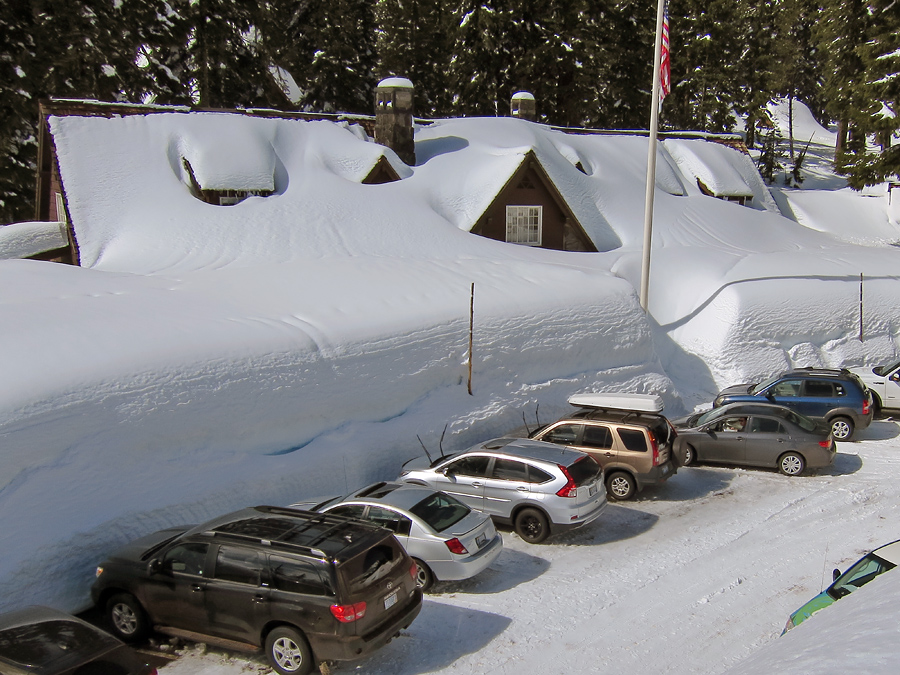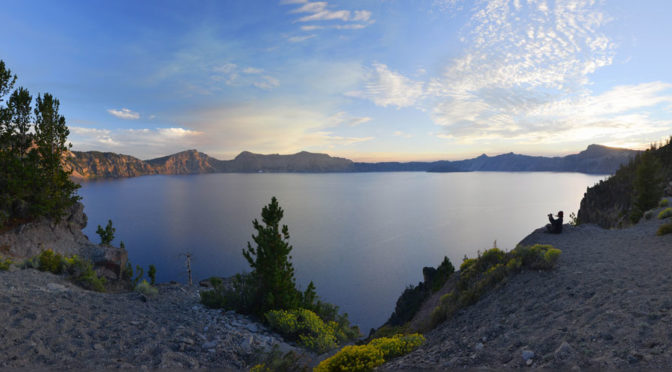Why does Crater Lake get so much snow?

The major weather patterns at Crater Lake National Park originate in the Pacific Ocean. Storm events originate in the north Pacific and build in strength and moisture content over the ocean. Wind patterns at these northerly latitudes move storms from the ocean to the Pacific Northwest.
Over 100 inches (250 cm) of rain falls each year on the Oregon Coast. After crossing the Coast Range, storm clouds descend into the Rogue and Willamette Valleys, dropping about 30 inches (76 cm) of rain. As storms move eastward, the high mountains of the Cascade Range push the cool, moist air to elevations over 10,000 feet (3,000 meters) in many places. As the air rises, it cools further. Water vapor in the air condenses to form clouds, and snow crystals form within them. If there is enough moisture in the clouds, the snow begins to fall. If the temperature is warm enough, the snow melts before it reaches the ground and falls as rain.
Are there any fish in the lake? Where can I go fishing?
There is no way to know for sure fish are not native to the lake because the first visitors stocked Crater Lake. They were introduced in the lake from 1888-1941. Six species were originally stocked, but only two have survived to today: Rainbow Trout and Kokanee Salmon. Because they are not native to the lake, fishing is not only allowed, it’s encouraged. No license is required and there is no limit on how many you may catch – the only rule is that you must use artificial bait. We don’t want to accidentally introduce any other species into the lake. Fishing is allowed along the shoreline and on Wizard Island (with the purchase of a boat tour and Wizard Island ticket.)
What kind of birds might I see?
Most common birds seen in the park: Raven, Clark’s Nutcracker, Gray Jay, Steller’s Jay, Dark-Eyed Junco, and Mountain Chickadee.
How cold is the water of Crater Lake? The average temperature (below 300 feet deep) is 38°. In the summer, the surface can warm up to 55° or 56°.
Where can I get to the lake to go swimming?
There is only one place where it is safe and legal to get down to the lake edge. It is the Cleetwood Cove Trail, which usually opens mid to late June. Visitors are welcome to swim in the lake from the shoreline at the end of this trail.
What kind of animals are at the park?
The most common are Roosevelt Elk, Mule Deer, Black Bear, Coyote, Bobcat, Porcupine, Yellow-bellied Marmot, Pine Marten, Snowshoe Hare, Pika, Golden-mantled Ground Squirrel, and Townsend Chipmunk.
What is the yellow stuff floating in Crater Lake?
Through the month of June and into July, yellow swirls of “stuff” can be seen on the surface of the lake and will always prompt great concern from the visitors. It’s not pollution or oil or some sort of chemical foamy stuff, it’s merely pine pollen. It’s harmless to the lake and will eventually settle out to the bottom.
Was there a volcano here?
Yes, and there still is! For approximately 400,000 years, volcanic eruptions here built up a 10,000 – 12,000 foot mountain now called Mt. Mazama. Seven thousand seven hundred years ago, the volcano exploded in a cataclysmic eruption. During this eruption, so much material was evacuated from the internal magma chamber that afterwards, there was not enough left to support the remaining mountain and it collapsed and created the hole – the caldera – that we now see today half filled with water.
Did they find the meteor that made Crater Lake?
This is not a meteor crater – a hole made by the impact of a big rock from space – so there is no meteor to find. Rather, this is a volcanic caldera – a hole made by the collapse of a volcano.


